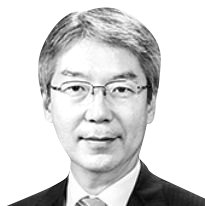[Column] Realistic measures to counter the nuclear threat

The author is a professor of international law at the University of Seoul and president of the Korean headquarters of the International Law Association (ILA).
Nuclear threats from North Korea are endless. After the legislation of nuclear armaments in the constitution of the Workers’ Party last September, the country continues to launch various types of ballistic missiles and even sends unmanned aerial vehicles across the border to take pictures of sensitive military facilities in South Korea. In announcing a bold plan to develop nuclear weapons in 2023, North Korean leader Kim Jong-un threatened to “mass-produce tactical nukes and increase the number of nuclear warhead exponentially.” If the North presses ahead with its seventh nuclear test, that will certainly push security on the Korean Peninsula to the zero-visibility territory.
Why does North Korea adhere to nuclear and missile tests despite harsh sanctions? The primary goal of this activity is a complete lifting of international sanctions on the recalcitrant state. In other words, the North wants to be recognized as a “de facto nuclear weapons state” beyond the boundaries of the Non-proliferation Treaty (NPT) as in the cases of Israel, India and Pakistan. North Korea believes it can maintain regime security as long as harsh sanctions are lifted. No doubt, the ultimate goal of a nuclear-armed North Korea is communization of the Korean Peninsula. Under such grim circumstances, South Korea must acquire strong nuclear deterrence on its own rather than blindly relying on the U.S. extended deterrence. South Korea’s conventional weapon supremacy over North Korea is nearly meaningless against a nuclear-armed enemy.
Nuclear armaments of North Korea are what the United States opposes the most. Shortly after the NPT entered into force in 1970, the U.S. has imposed strong sanctions on the development of nuclear weapons by other countries than the five nuclear powers of the U.S., Russia, China, the UK and France. Israel, India and Pakistan — countries not hostile toward the U.S. — could manage to become nuclear powers, but the current situation in Northeast Asia is dramatically different. There is little, if any, room for Uncle Sam to approve of the North’s nuclear armaments amid ever-tense Sino-U.S. contest in Northeast Asia and the rest of the world. The U.S. wants to tighten its encirclement of China through intensified sanctions on North Korea. The U.S.’s Indo-Pacific Strategy — based on the Quadrilateral Security Dialogue (Quad) with Australia, India, Japan and a bolstered tripartite security cooperation among South Korea, the U.S. and Japan, as well as a rule-based international order — should be comprehended in such a context.
Theoretically, South Korea can reinforce nuclear deterrence through its own nuclear armaments, the deployment of U.S. tactical nukes, and nuclear sharing with the U.S. Without consent from the U.S., however, South Korea’s nuclear armaments are not possible in a short period of time due to stumbling blocks such as the Korea-U.S. nuclear energy agreement (1974) — which bars the South from uranium enriched beyond 20 percent — and regulations from U.S. domestic laws and the constraints from the NPT and the International Atomic Energy Agency.
Redeploying U.S. tactical nukes is also impossible if the U.S. does not approve it. At the end of last year, the two countries denied the possibility that the tactical weapons will be redeployed in the South. But nuclear sharing can be possible if it can be adjusted to Korea’s situation. Seoul and Washington can devise the methodology of a nuclear sharing based on their recent discussions on operation of nuclear assets and information sharing.
South Korea must respond to the nuclear crisis by expanding the alliance with the United States to a multilateral security system. If the extended deterrence cannot ensure deterrence against the nuclear treat, it can be shared by U.S. allies. As South Korea and Japan can co-share security costs, the two countries need to strengthen their security coordination with America, develop it further and eventually launch a nuclear coalition including Australia. Related parties need to establish a powerful consultative body in East Asia like the Nuclear Panning Group (NPG) in the NATO.
Given the sharp confrontation over the NATO-style nuclear sharing between the United States and the Soviet Union in the past, concerned parties must address the NPT issue. Article 10 of the treaty stipulates that a member country can secede from it in case an emergency takes place in the country. As the North Korean nuclear threat can constitute a clear and present danger for South Korea, it can base its decision on the article. Another solution can be found in “suspending the implementation” of the treaty, instead of “withdrawing from it.” After all, the NPT regime did not work in the Korean Peninsula. The time has come for South Korea to prepare extraordinary measures — backed by elaborate logic — to effectively counter the mounting nuclear threat from North Korea.
Peace is not free.
Translation by the Korea JoongAng Daily staff.










with the Korea JoongAng Daily
To write comments, please log in to one of the accounts.
Standards Board Policy (0/250자)